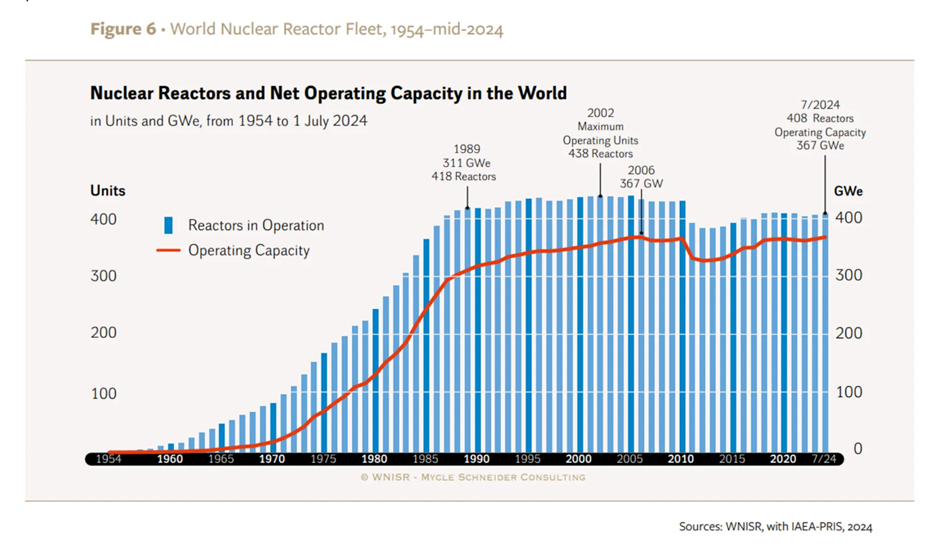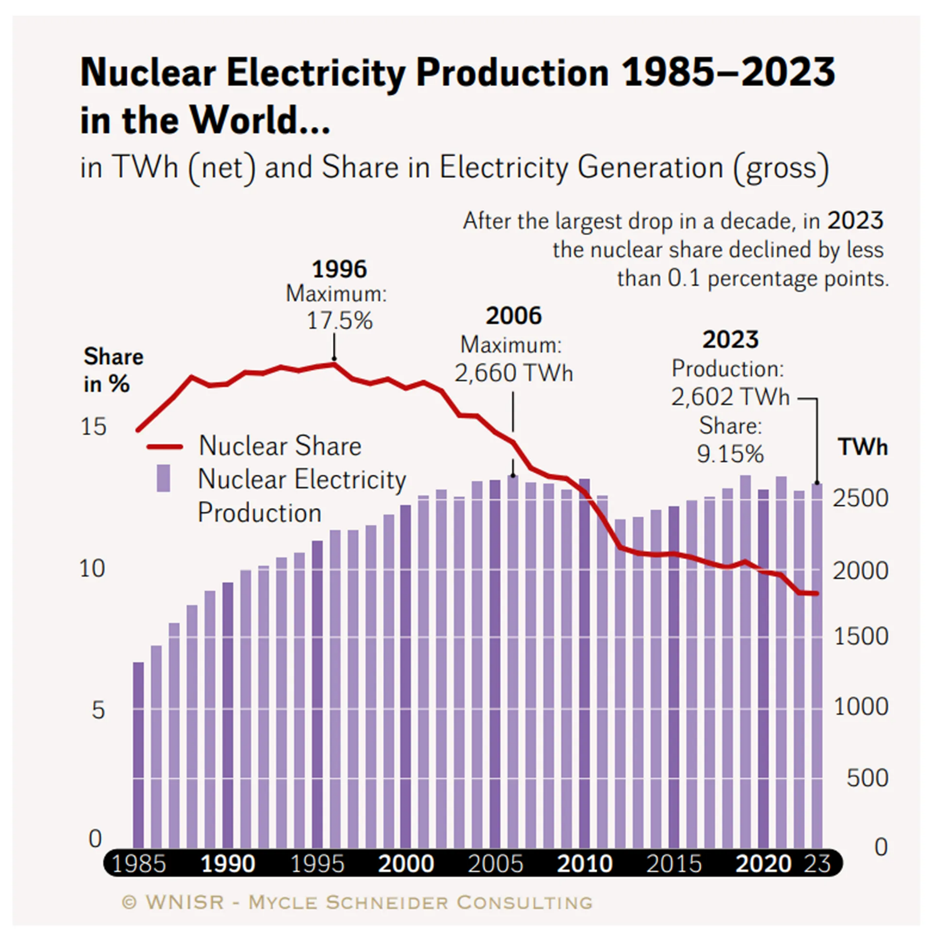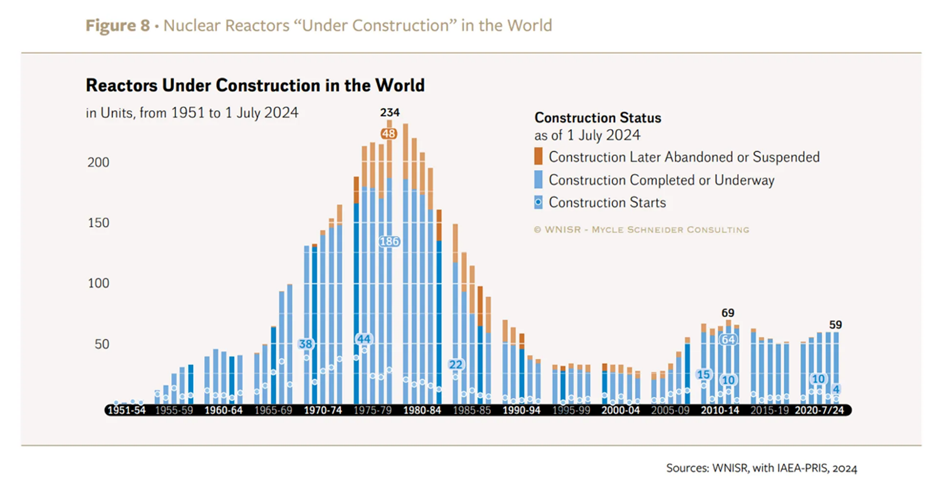Nuclear Monitor #928
Gerard Brinkman, WISE-Netherlands
When you read the headlines in the newspapers about breakthroughs in the nuclear world, don’t take them seriously.
According to some newspapers, new nuclear power plants are springing up like mushrooms. There is supposedly a booming sector worldwide. The International Energy Agency (IEA) published a report in January 2025, in which it talks about “The path to a new Era for Nuclear Energy”[1]. In the real world, however, nuclear energy is on the decline. A factcheck.
The past ten years
The International Atomic Energy Agency (IAEA) keeps track of how many new nuclear power plants are added to grid and how many are closed in a public database, Power Reactor Information System, PRIS [2]. Looking at the figures from 2015 to 2024, 67 new nuclear reactors started supplying power. In the same period, 66 nuclear reactors were permanently closed. In total, 1 reactor was added, not exactly ‘the new era’ that the IEA has in mind.
A group of independent energy experts annually compile the nuclear figures in the extensive World Nuclear Industrial Status Report [3] and they come to similar conclusions.

Since 1990, the number of nuclear reactors has fluctuated slightly above 400. The dip in 2011 had everything to do with the tsunami and the subsequent nuclear disaster in Fukushima, Japan. The country closed a large number of nuclear power plants. The red line in the graph above is the amount of electricity produced by existing nuclear power plants worldwide. It increases slightly every year. New nuclear power plants often have a greater capacity than the nuclear power plants that are closed. The IEA therefore already enthusiastically headlined that nuclear power will probably reach an all-time high record in 2025.
Share of nuclear power is declining
Looking a little closer at that “all-time high record”, there is something to be said about the claim. There is a small, steady growth of nuclear power output. But as a share of electricity production, nuclear energy is declining further and further. This is clearly visible in the previously mentioned WNISR.

The red line shows the percentage of nuclear power to global electricity production. The maximum for nuclear energy was in 1996. The share of nuclear energy then was more than 17%. In the meantime, this has fallen to just over 9%. Instead of growth or even stabilization, the share continues to fall.
In the real world, there is still little sign of a nuclear renaissance. Of course, this could change if suddenly a lot of nuclear power stations are under construction. However, that does not seem likely.
According to the WNISR, just over 60 new reactors have been under construction for years. Since the construction period is on average around ten years, around 6 to 7 new nuclear reactors are added each year. This corresponds to the 67 new nuclear power plants over the past ten years, mentioned before in this article. But nuclear power plants will also be closed. Even if you can extend their lifespan, they will still age and will have to be closed sooner or later. A large number of nuclear power plants were built between 1975 and 1985. These nuclear power plants are therefore more than forty years old, may last another ten to twenty years, but will then really close at some point. It is therefore expected that the number of nuclear power plants will decrease in the coming years instead of increasing.

What about the ‘small ones’: SMRs?
For many nuclear fans, the Small Modular Reactor is the promise of the future. They are supposed to be easy to build due to their small size, can be easily assembled on the building site like an Ikea cupboard, and are supposed to be inherently safe. There are now more than 100 players on the market, all of whom believe that their design has a good future. The problem, however, is that we have hardly any experience with SMRs. A few pilot designs have been built in Russia and China, but in the western world there have only been disappointments so far. The American NuScale has been developing an SMR since 2007 and for a while it even seemed that a number of them would be built in Idaho. But in the end, the regional governments could not settle the financing and the project was terminated[4]. All SMR designs are still in the phase of research or approval by a nuclear authority.
As with the large nuclear power plants, a major problem lies with the costs. Even if a few dozen of a certain design are built, that does not yet bring with it the economies of scale that should ultimately make the SMR cheaper. Then you will have to build a few hundred of them and there is no prospect of that. In any case, it will take years before the first SMR is built in the West and then it is questionable whether many will follow.
When you read headlines about breakthroughs in the world of nuclear energy, don’t take them seriously. Nuclear energy is on its way out.
[1] https://iea.blob.core.windows.net/assets/b6a6fc8c-c62e-411d-a15c-bf211ccc06f3/ThePathtoaNewEraforNuclearEnergy.pdf
[2] https://pris.iaea.org/pris/
[3] https://www.worldnuclearreport.org/IMG/pdf/wnisr2024-v2.pdf
[4] https://www.world-nuclear-news.org/Articles/Idaho-SMR-project-terminated